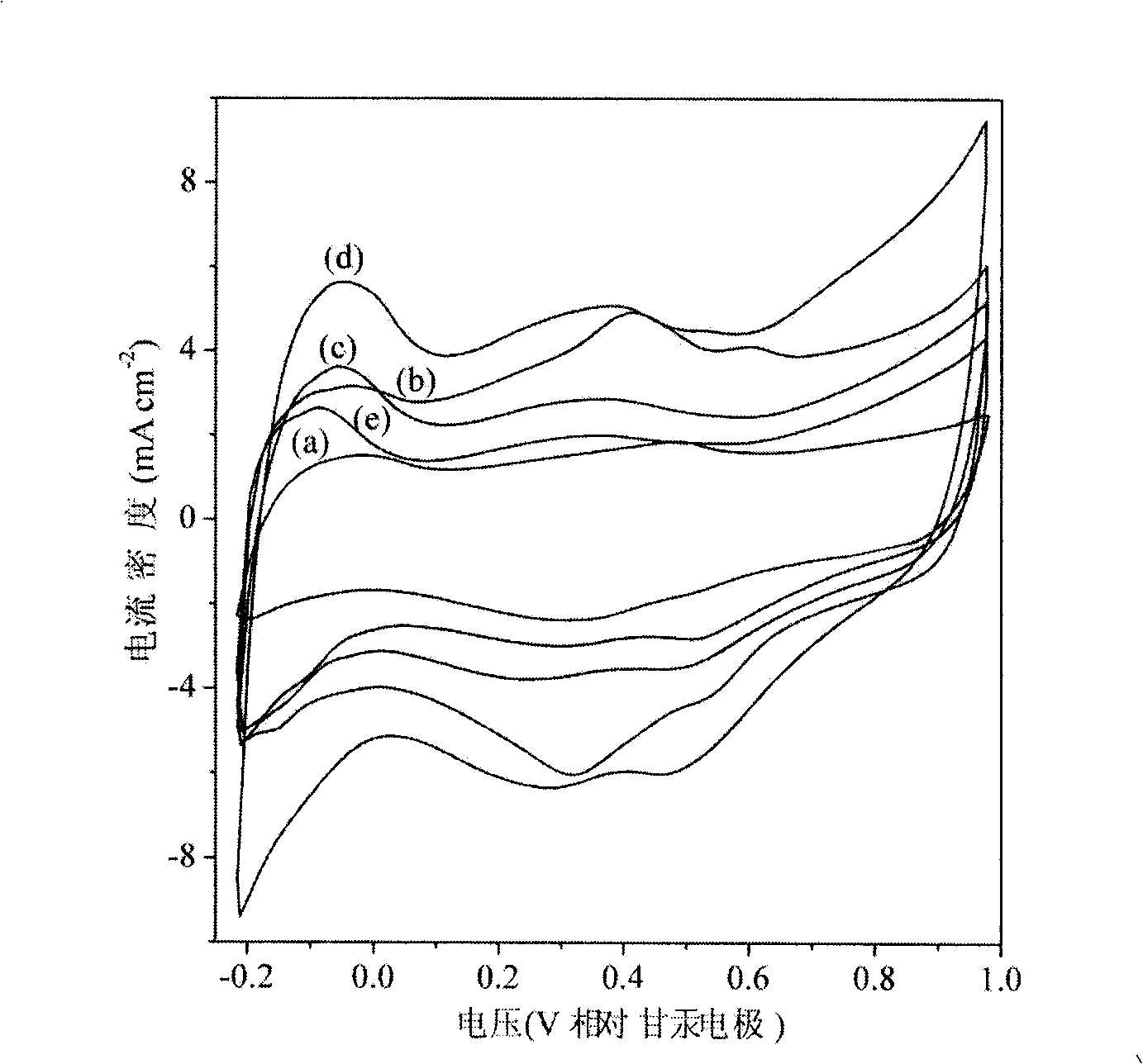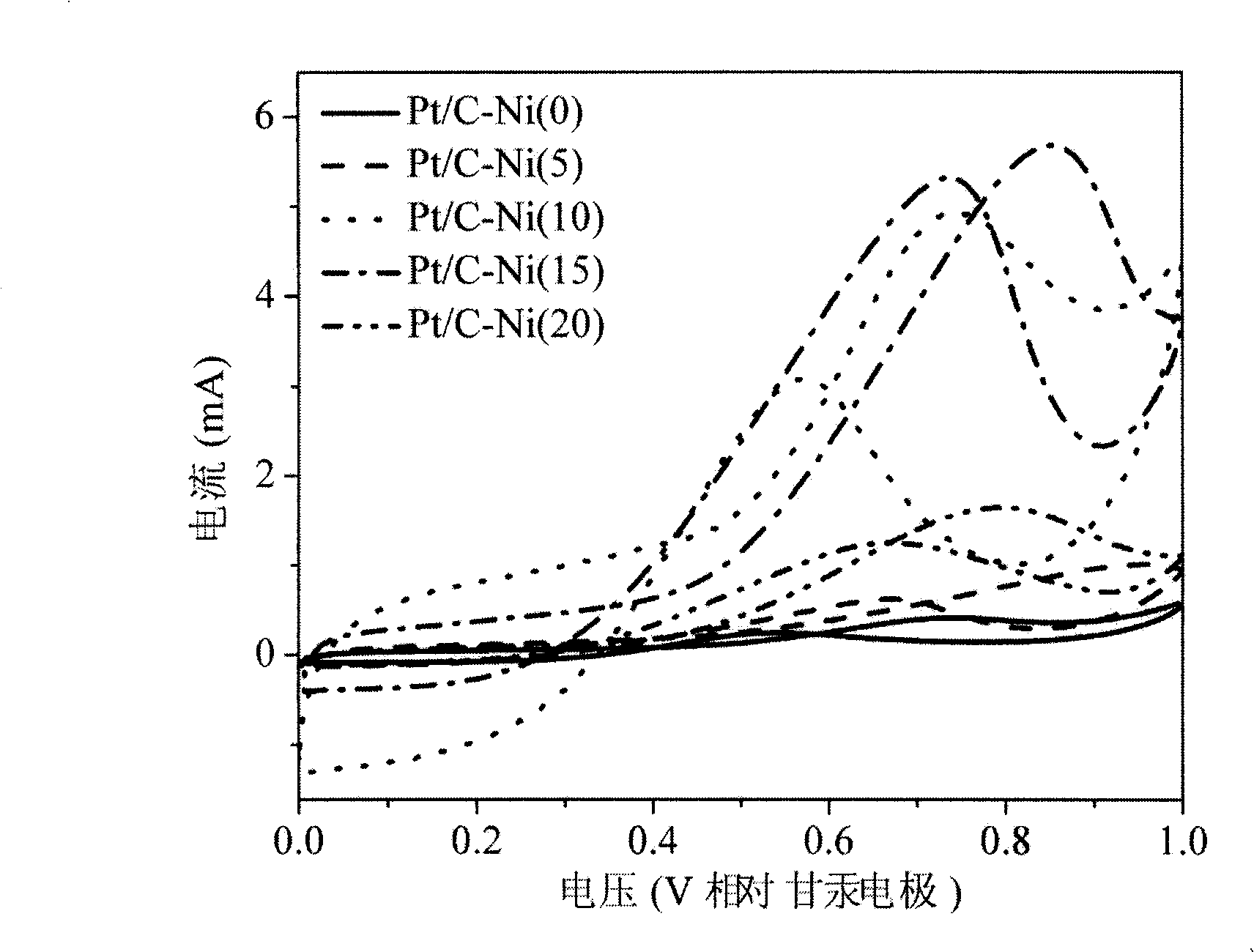Nickelous chloride assisted synthesis method of fuel cell catalyst carrier ordered mesoporous carbon
A catalyst carrier, fuel cell technology, applied in catalyst carriers, physical/chemical process catalysts, chemical instruments and methods, etc., can solve the problems of low loading rate, weakened electrocatalytic performance of Pt nanoparticles, and difficulty in dispersion.
- Summary
- Abstract
- Description
- Claims
- Application Information
AI Technical Summary
Problems solved by technology
Method used
Image
Examples
specific Embodiment 2
[0019] Specific embodiment two (comparative example):
[0020] (1) Dissolve 1.0 g of surfactant F127 in 10.0 g of absolute ethanol, and stir to form a transparent solution. Without adding nickel chloride solution, stirring was continued at 40°C for 1h. Slowly add 2.08g tetraethyl orthosilicate and 2.5g ethanol solution (20%) of phenolic resin dropwise, stir for 2h to make it evenly mixed.
[0021] (2) Transfer the mixture to a flat-bottomed evaporating dish, evaporate the solvent at room temperature (25°C) for 5-8 hours, put it in a vacuum drying oven at 100°C for thermal polymerization for 24 hours, and form a soft film.
[0022] (3) Carbonization is carried out in an atmosphere tube furnace with nitrogen gas flow. Insulate at 900°C for 2 hours, and the heating rate is strictly controlled at 1°C·min -1 , that is, ordered mesoporous carbon-silicon oxide composites.
[0023] (4) Soak the carbonized and ground sample with a mixed solution of NaOH, ethanol and water (mass rat...
specific Embodiment 3
[0027] (1) Add nickel chloride solution on the basis of soft template self-assembly method. Namely: Dissolve 1.0 g of template agent F127 in 10.0 g of absolute ethanol and stir to form a transparent solution. Add 4.0mL, 0.2mol·L -1 Nickel chloride solution was stirred at 40°C for 1 h. Slowly add 2.08g tetraethyl orthosilicate and 2.5g ethanol solution (20%) of phenolic resin dropwise, stir for 2h to make it evenly mixed.
[0028] (2) Transfer the mixture to a flat-bottomed evaporating dish, evaporate the solvent at room temperature (25°C) for 5-8 hours, put it in a vacuum drying oven at 100°C for thermal polymerization for 24 hours, and form a soft film.
[0029] (3) Carbonization is carried out in an atmosphere tube furnace with nitrogen gas flow. Insulate at 900°C for 2 hours, and the heating rate is strictly controlled at 1°C·min -1 , that is, ordered mesoporous carbon-silicon oxide composites.
[0030] (4) Soak the carbonized and ground sample with a mixed solution of...
specific Embodiment 4
[0034] (1) Add palladium chloride solution on the basis of soft template self-assembly method. Namely: Dissolve 1.0 g of template agent F127 in 10.0 g of absolute ethanol and stir to form a transparent solution. Add 2.0mL, 0.2mol·L -1 The palladium chloride solution was continuously stirred at 40°C for 1h. Slowly add 2.08g tetraethyl orthosilicate and 2.5g ethanol solution (20%) of phenolic resin dropwise, stir for 2h to make it evenly mixed.
[0035] (2) Transfer the mixture to a flat-bottomed evaporating dish, evaporate the solvent at room temperature (25°C) for 5-8 hours, put it in a vacuum drying oven at 100°C for thermal polymerization for 24 hours, and form a soft film.
[0036] (3) Carbonization is carried out in an atmosphere tube furnace with nitrogen gas flow. Insulate at 900°C for 2 hours, and the heating rate is strictly controlled at 1°C·min -1 , that is, ordered mesoporous carbon-silicon oxide composites.
[0037] (4) Soak the carbonized and ground sample wi...
PUM
| Property | Measurement | Unit |
|---|---|---|
| specific surface area | aaaaa | aaaaa |
| specific surface area | aaaaa | aaaaa |
Abstract
Description
Claims
Application Information
 Login to View More
Login to View More - R&D
- Intellectual Property
- Life Sciences
- Materials
- Tech Scout
- Unparalleled Data Quality
- Higher Quality Content
- 60% Fewer Hallucinations
Browse by: Latest US Patents, China's latest patents, Technical Efficacy Thesaurus, Application Domain, Technology Topic, Popular Technical Reports.
© 2025 PatSnap. All rights reserved.Legal|Privacy policy|Modern Slavery Act Transparency Statement|Sitemap|About US| Contact US: help@patsnap.com



